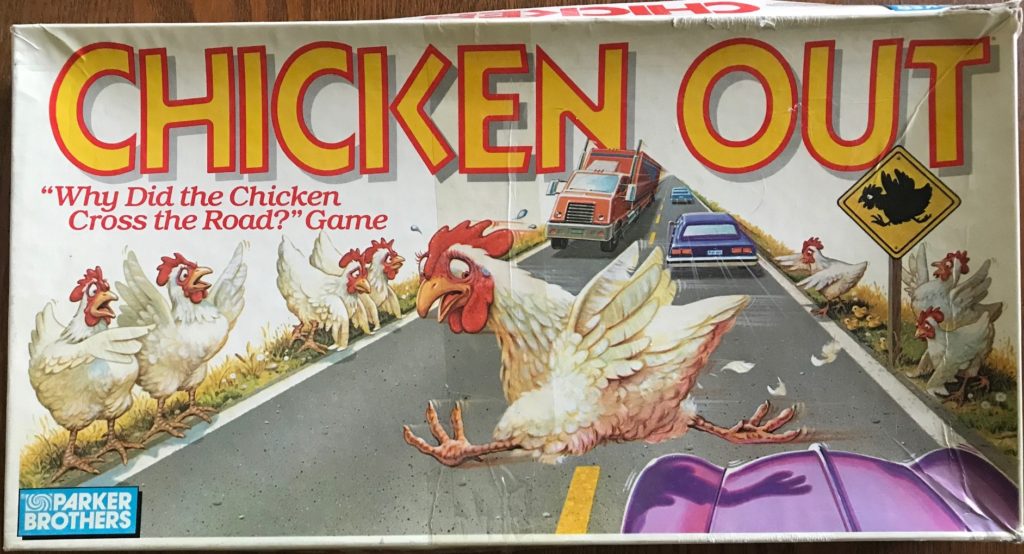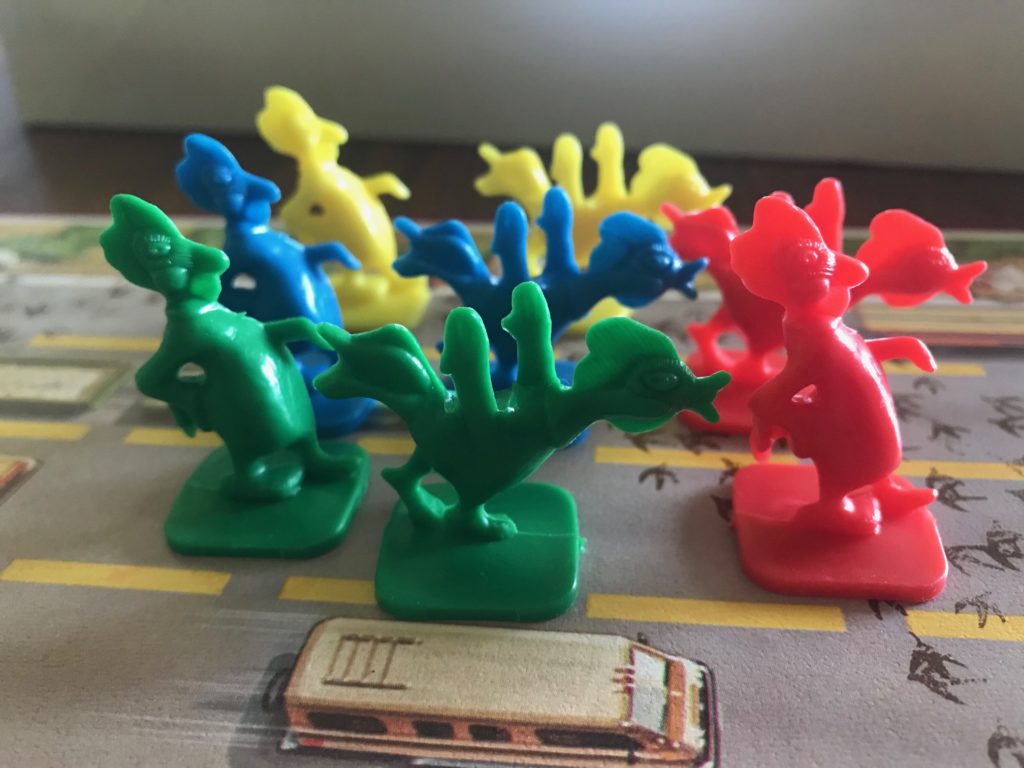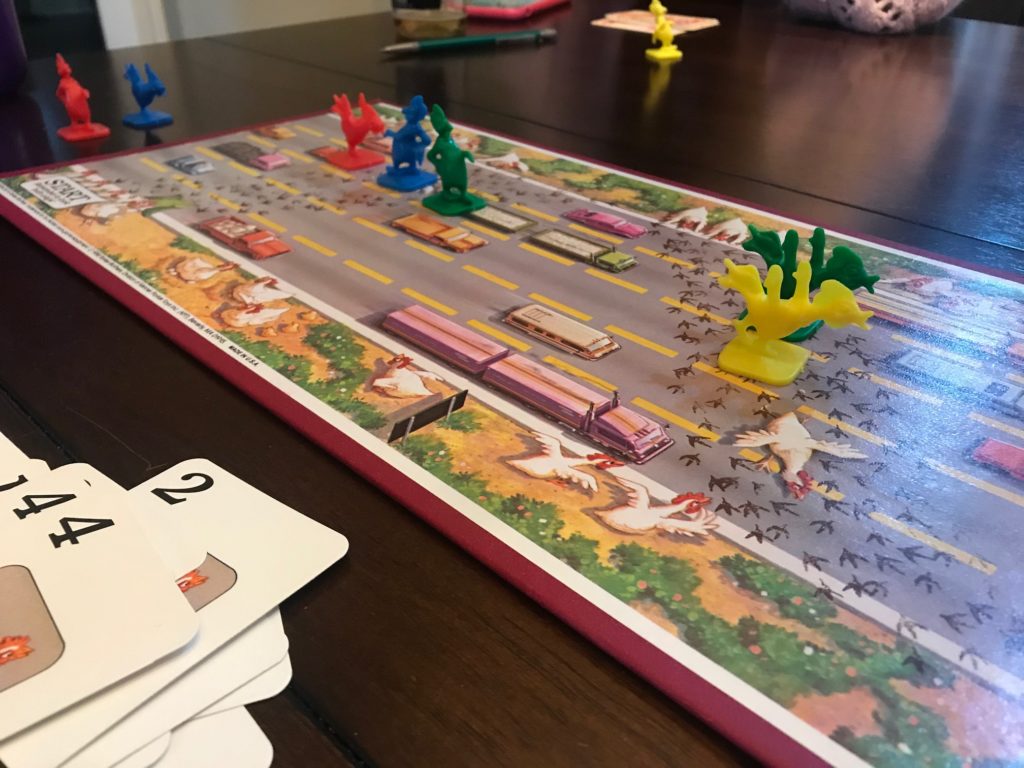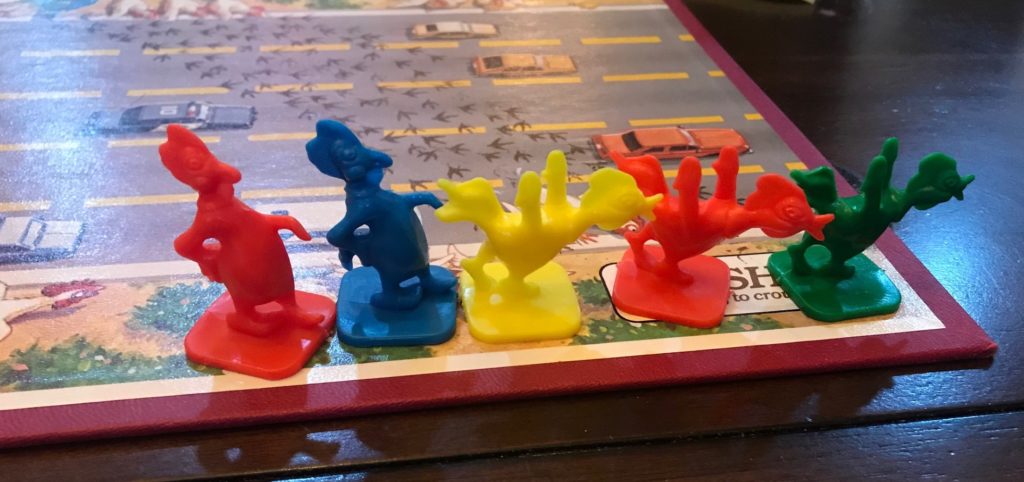Review: Chicken Out
Publisher: Parker Brothers
Year: 1988
Tagline: “Why Did the Chicken Cross the Road?” Game

how we met
I found Chicken Out for the first time for $5 at a flea market, but the seller would not let me open it and did not know if it was complete. I also didn’t totally want to carry it for the remaining miles that I would be wandering around. So that was a pass for me. The next time I found Chicken Out was for $2 at the local thrift shop. That’s more my speed, and I was happy to give it a whirl.
how it plays
Your goal in Chicken Out is to be the first player to get both of your chicken pawns safely to the FINISH space at the end of the road. You do this by lacing in and out of traffic using cards to move.

To begin play, shuffle the deck and deal four cards to each player. Players should not show their hand to any other players; bluffing is a key part of gameplay. The remainder of the deck goes face down as a draw pile.

On a player’s turn they simply play one card from their hand, do whatever is needed by the card, discard the card in a face up discard pile, and then draw to get up to four cards again.
There are four types of cards:
- Number cards allow you to move one of your chickens that number of spaces (NOTE: the grassy edge of the road is not considered a space for movement, only for safety). You do not have to move your first chicken all the way to finish before starting your second chicken. Just be careful because chickens in roads are vulnerable and may need protection.
- Chicken cards are played by placing the card face down in front of you and hollering, “Chicken!” There are three Chicken cards of each color in the deck, and only one Chicken card that is all four colors. When you place the card face down, you are threatening the chickens whose color you played, but other players do not know whether it is their color or not. (You can play your own color and your chickens remain safe.) Other players must decide whether to try and protect their flock or not. Not protecting a chicken whose Chicken card was played will send it all the way back to START!!!! These are the choices after another player plays a Chicken card:
- Play a Safe card for one or each chicken. Making both of your chickens safe will require two Safe cards. If you only have one Safe card you must pick which chicken is protected if you have more than one on the board.
- Play a Goose card and move one of your chickens to the next safe area on the board (the grassy lane). Similarly, moving ahead two chickens would require two Goose cards. These cards can only be played on an opponent’s turn.
- Decide to Chicken Out and move your chickens backwards to the previous safety areas. You lose ground, but they are safe from further harm that turn. This is not a card but a decision that you can always make.
- Ignore the threat and hold tight. Maybe your opponent was bluffing with their own color card, or maybe it is one of your opponents’ colors. But remember, if the Chicken card is your color then your birds are moved back to START!
- NOTE: You can do any combination of the above as long as you have the right cards.
If you don’t have a movement card in hand and want to skip your turn, you can discard and draw another card to account for your turn.

The first player to get both of their Chicken pawns to the FINISH space wins Chicken Out!
how it went
Well, my copy was complete other than the insert that includes the instructions. Shout out to the A Board Game a Day blog who not only has approximately 13 bazillion reviews including some fun, vintage toys and games, but who also uploaded the instructions of Chicken Out for my desperate self to find.
That became important, too, because for some reason we did not all agree on which spaces of the game board were spaces in play. I figured if any of us were confused then others may be too. The instructions have a nice diagram showing example movement that should clear up any confusion and keep you off the grassy sides.

Apart from that rocky start gameplay was straight forward. And fairly fun too. We don’t shy away from “take that” mechanics so our chickens were flying back to start, occasionally from very late in play. At four players, we went through the deck around 1,800 times.
Playing a Chicken card face down without announcing the color means that bluffing is an undeniable part of gameplay. There is a bit of strategy with regards to how you decide to play, specifically when to protect your chickens or when to attack vs move. But a lot of your success will depend upon the cards you draw. Sometimes you have two options for what to do on your turn, but a lot of times you may only have one.
The game is not terribly exciting unless you choose not to protect your chickens. But you can always take that backward Chicken Out movement to continue inching forward. Chicken Out is just waiting to remind us of the seemingly implausible lessons from “The Tortoise and the Hare” fable.
John was doing well in our game, but I think his chicken pawns might have even left tracks on the game board for how often they traveled the last section before FINISH. He just kept getting sent back to safety.
I eventually won our play of Chicken Out. I had very lucky draws; I’m not sure any other player even touched the four color Chicken card. I also had good diversity in Number cards, Chicken cards and the protection cards. But I also did not scoff at moving back a few spaces to save my overall progress. I “Chickened Out” plenty of times. I also waited until one of my chickens was safely home before I let the other one start. Fewer targets just seemed wise. And it’s not like I was playing Dizzy Dizzy Dinosaur and could stack them three-high into one giant pawn! I definitely would have done that. At any cost.

play or pass
I think pass. Chicken Out is more middle-of-the-road for me because it’s easy to play and can be a fun press your luck game. But for all its simplicity, gameplay can take awhile. The few choices and limited card types that are constantly recycled aren’t enough to maintain amusement throughout an overly long play.